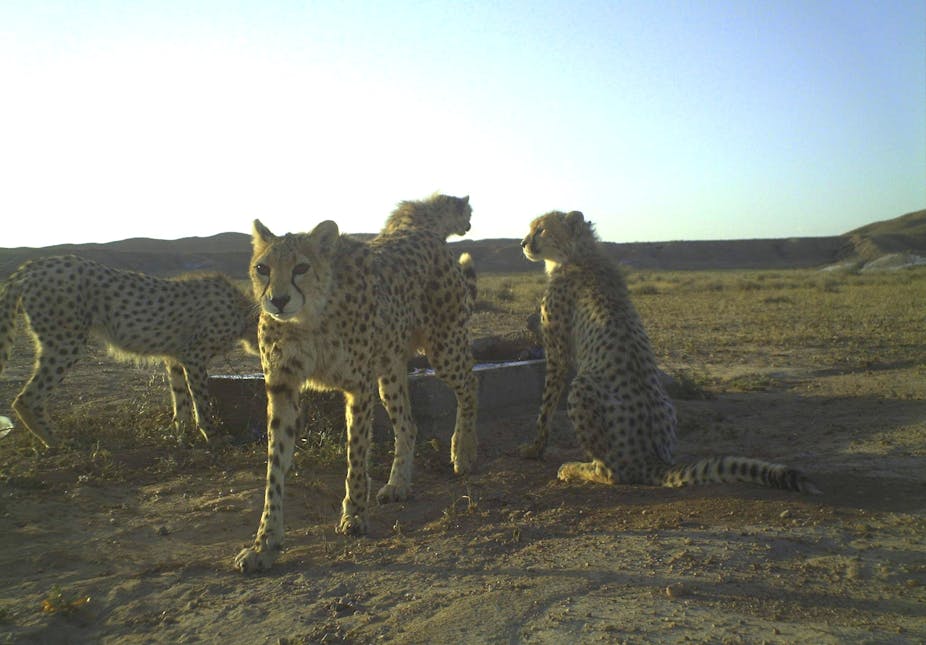The last few surviving Asiatic cheetahs live in Iran, where they stalk the hyper-arid landscape, where temperatures swing from -30°C to 50°C. This is the only place in the world a cheetah, most of which live in Africa, will experience snow.
Iran is home to the last known population of Asiatic cheetah, a creature which once roamed across vast ranges of west and south Asian countries, from the Middle East to India. Today, the cheetahs are known only from around 15 reserves in Iran, all officially protected by the country’s government.
Together with genetic distinctiveness from their African cousins, the Asiatic cheetahs are smaller and more slightly built. Iranian biologists were surprised to learn that the Asiatic cheetahs are mainly found in mountainous regions – a very different proposition from the view expected from wildlife documentaries in which cheetahs pursue sprinting gazelles across open plains.
Camera traps are reliable tools to try to gauge the population of these spotted cats, whose markings are individually unique. However, this technology has been rarely applied to cheetahs across their global range due to the paucity of individuals and their elusive nature. Due to political sanctions, the necessary equipment is not easily available in Iran, and this has prevented a thorough assessment of the species in the past.
Thanks to various donors and partners, including Panthera and Dutch NGO Stichting SPOTS, a monitoring program was recently launched that would fill the gaps in our knowledge about the cheetah that is essential for its protection. Even so the results were surprising, revealing only 40 to 70 cheetahs across the country – smaller even than previous estimates of up to 100. Listed as critically endangered by the IUCN, the Asiatic cheetah is among the rarest cats in the world at subspecies level, after the Amur leopard.
Guarding Iran’s last cheetahs
Around 125 game guards protect the cheetah’s range in Iran as Cheetah Guardians, thanks to tremendous efforts of the Conservation of Asiatic Cheetah Project (CACP), the Iranian Department of the Environment (DoE), and UNDP in Iran, which tried to double the number of guards employed by the DoE during the past decade. Equipped with 4WD vehicles and motorbikes, each guard is responsible for protecting around 640km2 of the landscape, an indication that more forces are needed.
In order to safeguard the cheetahs, the DoE established more reserves while existing reserves received more resources. In the Iran’s northeast Miandasht Wildlife Refuge has been a key site for the cheetahs after a threefold boom in prey species. As a result, the cheetahs have established a breeding population there, vital to help re-colonise other reserves.
As is the case for many wildlife species, the cheetah was little known among the public ten years ago. But with the animals’ plight appealing to the media it has garnered considerable coverage, leaving the public in no doubt about the state of the cheetah’s decline. With united effort from government and NGOs, this year the cheetah even became the first species to appear emblazoned on the Iranian national football team’s jersey during the 2014 World Cup in Brazil.
So as a symbol of the nation’s wildlife, the public awareness and support the cheetah receives is an important step to ensure its long-term survival. But it is not enough. It is vital to build an expert opinion on what to do about the species’ critically small population, rising mortality from human causes, such as traffic collisions, and falling birth rates.
While further research is needed, we know that Asiatic cheetahs have much lower genetic diversity than African cheetahs, but we are still hopeful that better connectivity between the various reserves to allow cheetahs to intermingle could maintain a basic level of gene flow between small cheetah populations.
We need the authorities to confront and defeat plans for property development and infrastructure such as roads, mines and railways within the main cheetah reserves. For example, a road to be constructed through Bafq Protected Area in central Iran was a major concern, but the DoE managed to stop construction and propose an alternative route.
Cheetahs are known to kill small livestock, and claims of cheetahs killing young camel, sheep, and goat are rife among shepherds. Recent cases in different parts of the country have raised concerns that cheetahs could be killed by protective herders. At least five have been known to be killed by herders since 2010, twice the number killed in the previous decade. To try to prevent this, the Iranian Department of Environment and CACP established a programme to compensate for cheetah predation for five years.
On August 31 1994 a cheetah was rescued from dying of thirst in central Iran. Named Marita, for nearly ten years she was the only evidence of the existence of cheetahs outside Africa. In 2007, the Iranian Cheetah Society (ICS) designated August 31 as National Cheetah Day, an annual event to draw people’s attention to conservation issues in Iran. The cheetah is lucky to have a day bearing its name, but to survive they will need much more than luck.

